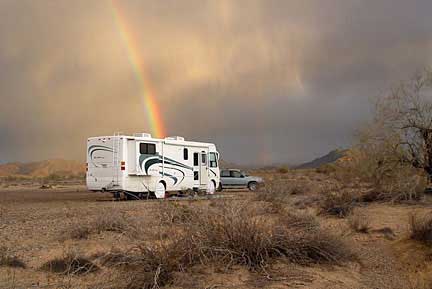Chaco Culture 2009
Chaco Culture National Historical Park is an ancient civilization site in northwest New Mexico that is over 1,000 years old. We went there in 2006 and loved it, largely because it is one of the few places where excavated ruins can be explored with few restrictions. Visitors are not required to go in groups with escorts as in most such parks and it is not crowded.

The reason is that getting to Chaco requires driving 12 miles of unpaved county road that can be really bad at times, and this trip was much worse than the last. It does not look bad in the photo but it is badly washboarded, limiting speed in the RV to less than 15 mph. Fajada Butte, visible on the right horizon, marks the park location.
There is a lot of controversy over the proposed paving of this road. Those in favor argue that easy access should be available to everyone. Those opposed fear that increased visitation would degrade the intimacy of the experience and lead to more damage to the environment. We prefer the way it is, bumps and all.

Fajada Butte is the most predominate geographical feature in the area and may have been what attracted the ancient people to the location. Indeed it would have served as a beacon but it is not visible from the largest ruins and no evidence that it had religious or cultural significance.

The Chaco campground is small and has no water or electricity but is in a nice location adjacent to a small ruin.

One of the largest ruins is Chetro Ketl, the central feature of which is this giant kiva. It was covered with a flat roof supported by four large wood columns on round foundations. One, containing the small tree, is visible in the photo. The four stone discs were in the foundations. Beneath the discs was a leather sack filled with crushed turquoise, probably placed there for ceremonial reasons. The rectangular structure with the hole is a fireplace, traditionally located south of the structure's center.


Nearby Pueblo Boniti is only about 1/2 mile from Chetro. There are somewhere around 700 small rooms there, giving it the appearance of an apartment house. Archeological studies however have found no evidence that large numbers of people actually lived here. Things normally associated with human habitation, burial sites and trash dumps for example, are missing. The prevalent theory is that it was primarily a ceremonial or government site and that the people lived in nearby villages.


Chaco is an awesome place and well worth enduring the lousy road.


0 Comments:
Post a Comment
<< Home